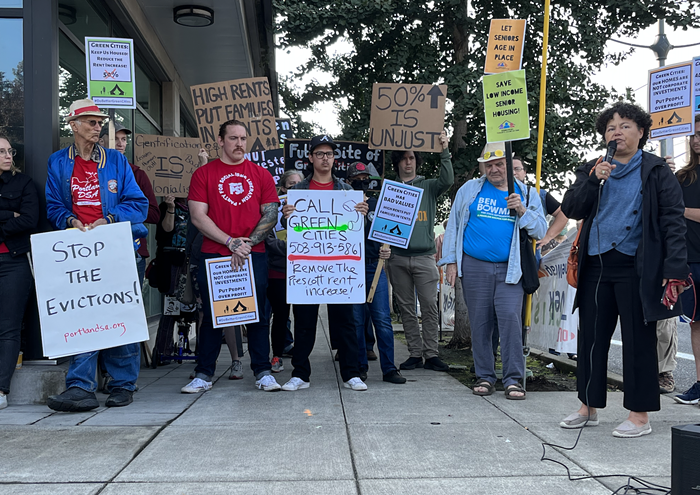THE NUG SHELVES are empty again at the Portland-area's largest retail pot store, so Brian Budz suggests we meet for lunch in a Vancouver shopping center.
Over brisket and red wine, the co-owner of Vancouver, Washington's New Vansterdam is animated as he lays out the insanity of recent weeks. He talks of money-hungry pot farmers raising prices to untenable levels, and of the unfortunate state policies that gave them that power. He bemoans a confusing tax structure that has customers paying through the nose for their buds, but leaves retailers like him with painfully thin margins.
Since unlocking the doors of New Vansterdam a little more than a month earlier, Budz hasn't been able to keep them open for even a week at a time. He sold 30 pounds of pot in the store's first two hectic days, and then promptly had to close due to lack of product. Each new, precious influx of product brings long lines—lines choked with Portlanders, no doubt—and higher prices for both Budz and his customers. Even with the meteoric cost of a gram of weed in Washington's new market, his product still moves.
But Budz is worried he won't be able to keep up.
"If the state chooses not to correct it, I will not stay in business," he says. "If they don't correct it, it's going to fail."
He's got company. Since Washington's first retail shops opened on July 8, the market resembles a trigger-happy frontier town in the throes of a very limited gold strike. Growers and retailers are squaring off against each other, squabbling among themselves, making dire predictions, and damning the state for ill-conceived strictures on their sweet green schemes.
It's ugly—a far cry from the comparably placid legalization process in Colorado. And it could be Oregon in the near future.
TWO YEARS AGO, Budz and his fellow Washingtonians were like Oregonians today—contemplating a pot legalization measure that promised a well-regulated market, despite offering few concrete details on how that new policy would look. Like our Measure 91, which voters will decide in just two months, Washington's Initiative 502 included a loose framework for legalization while placing the majority of discretion in the hands of the state's liquor control bureaucrats.
There are key differences in the proposals, but if Oregon gives the nod to legal weed as many expect, the law's success or failure is going to depend a lot on an agency that sees few positive headlines as-is: the Oregon Liquor Control Commission (OLCC).
Washington's lessons, then, are partly ours.
"What you vote for in the people's initiative is not always what you get," says Hilary Bricken, a Seattle attorney who's worked extensively with business owners laboring under the state's recreational pot laws. "Because of the mechanism, people are writing a blank check to the liquor control commission. In Washington, nobody saw this coming."
Measure 91 does offer some specifics—and apparent lessons. In pitching the law, proponents often say they've taken the best parts of both Washington's and Colorado's systems, for a solution "tailor made" for Oregon.
"The biggest benefit that Oregon has over Washington is learning from both Washington and Colorado," says Anthony Johnson, an attorney, pot advocate, and chief petitioner behind Measure 91. "We think we've taken a balanced approach."
JEREMY MOBERG figures he's probably one of the gougers everybody's talking about.
A trim and outspoken pot farmer in a sun-soaked expanse east of Washington's North Cascades, Moberg runs CannaSol Farms, where he cultivates as much pot as his state currently allows: a 21,000-square-feet canopy. But unlike many of the state's growers, CannaSol grows solely outdoors, slashing costs by using the sun instead of power-chugging lights.
Despite that lower overhead, Moberg's product—strains like "Burmese Kush" and "Girl Scout Cookie"—can cost shops more than $12 a gram. That retails in Vancouver for upward of $30 before sales tax, far higher than black market or medical marijuana prices. It's not the most expensive product around, but it's up there.
Moberg says that's how it should be. He disdains retailers who are whining about high prices.
"The price is too high when you don't have 150 people lined up outside your door anymore," he says, "and you're not selling out your product in five hours."
And it goes both ways, Moberg says. He mentions a recent story in the Seattle Times that told of a small-scale grow operation in Seattle selling product for $7.73 a gram, and the retailer turning around and charging $42.33.
"I was offended by that story," Moberg says. "Basically they gouged the producer." But then he offered an absolution for the cutthroat jockeying: "There's no blame to go around when scarcity drives the market."
That scarcity is a big reason for the current squabbling in Washington. And it's largely due to how the Washington State Liquor Control Board (WSLCB) used its discretion under I-502 to implement legal weed.
Fearing the wrath of the feds, the WSLCB created a choke point for how much pot could be grown in the state: two million square feet of canopy. That's enough, the agency says, to satisfy between 13 percent and 25 percent of demand for pot in Washington. It is a starting point.
But the WSLCB, in deciding not to explicitly limit the number of pot farmers and processors (the folks who trim and package marijuana flowers, or change the buds into oils and edibles), also didn't count on the amount of people who'd want in on this new market.
It received thousands of applications for producer and processor licenses during a 30-day window late last year, according to spokesman Brian Smith. In the crush that followed, the board hastily chopped the amount of licenses people could receive, down to one each, and the amount of pot they'd each be able to grow by 30 percent. Licenses dribbled out to producers slower than expected, and growers ready to produce hundreds of pounds were forced to wait for official permission.
When Washington's first retailers were allowed to open their doors on July 8, nowhere near enough crop stood ready. There's still not enough, and no one really agrees on when that's going to change.
"I was ready [to grow] on February 15," Moberg says. "I could have had 1,000 pounds to market on July 8, and you wouldn't be talking about how bad prices are. But I didn't get licensed until the end of May."
To date, the state has licensed 190 growers and processors, accounting for 1.7 million square feet of canopy, Smith says, and is still working through applications. The WSLCB has given the green light to 50 retailers statewide out of a maximum of 334. In the first month of sales, the board recorded $804,000 of tax obligation (it's collected $780,000 so far).
THE MUDDLED licensing process and low initial ambitions for pot supply are some of the most frequent criticisms leveled at Washington's pot policy. (High taxation, actually written into I-502, is another biggie.)
At a maximum 25 percent of demand, two million square feet won't come close to eradicating the black market, one of I-502's stated goals, critics point out. And they say the state should have planned better to avoid imperiling nascent pot businesses.
A recent report from the Brookings Institution called the WSLCB's efforts "an odd mix of deliberateness and irresoluteness" (while lauding the state for efforts to study the long-term effects of legal pot). Libertarian magazine Reason compared the canopy limit to the downfall of the Soviet Union, noting the USSR discovered that "coordination of supply and demand is a pretty complicated problem when you try to arrange it from the top down."
"It makes me nervous," says Ed Dolan, a Yale-trained economist and Washington resident who voted in favor of I-502. "If they restrict the development so it's too restrictive, the market fails; the black market continues with business as usual."
No one could have predicted these criticisms back in September 2012, because I-502 never mentioned canopy limits or license criteria. Instead, like Oregon's Measure 91, it gave the liquor control agency broad discretion in how to craft the details of legalization, and the WSLCB ran with it. The thinking was that alcohol and pot would be essentially the same to regulate.
"It's coming out that they're not similar at all," says Bricken, the Seattle business attorney. "Eventually marijuana will move almost exclusively to departments of health or agriculture. They're better equipped."
(In Colorado, the department of revenue oversees regulation.)
WSLCB spokesman Smith is used to the gripes—and dismissive of them.
"A lot of guys get a chance to bellyache with the press," he says. "It's not necessarily the reality."
Smith says the limit of two million square feet will go up, but couldn't say when. It was set low to get the market started, he says, and to assuage the federal government's fears that legal weed might end up on the black market. (Pot might be okay in the eyes of Washington State officials, but it's still illegal to the folks in Washington, DC, who've set tight, tenuous conditions on the Washington and Colorado markets.)
"Of course the [US] Department of Justice is going to balk at a 40-million-square-foot canopy," Smith says
But if the WSLCB has plans to raise the limit—which is written into its rules—it's done a poor job communicating that to the public. No growers or retailers contacted for this story knew of any plans to raise the canopy limit, though some assumed it would happen.
"Washington's going to have a very robust supply, and it's going to come soon," Smith says. "The system is emerging. It's doing well."
THE STORY PAINTED by many in the market is rockier.
Retailers like Budz tell the Mercury of some farmers arbitrarily driving up prices with each new delivery, and the fear that shortages and frequent closures will drive customers back into the arms of the black market.
"There are growers out there who don't have a clue what they're doing," Budz says. "They don't know what their margins are. They're picking numbers out of the blue, and they're selling stuff that is just subpar."
Other retailers talk of bidding wars erupting over the scarce product. John Evich, who works at Bellingham's Top Shelf Cannabis, says a competing shop recently tried to snake his incoming shipment of marijuana edibles by offering the processor double his price. Similar bidding wars among suppliers crop up all the time, he says.
"One of them was offered $20 a gram for their product," Evich says, "so where's the price gouging really coming from?"
At the same time, there is disagreement between farmers who choose to grow indoors and those who use the sun.
Moberg, who leads a coalition of outdoor growers, argues his product is more environmentally sustainable, because it doesn't tax the state's power grid. But he says indoor growers have an unfair advantage: They can harvest year-round. He's dictated by growing seasons.
"We want parity with the indoor growers," he says, suggesting an annual cap on how many pounds of marijuana a producer can harvest.
"Well, then, fucking grow indoors," says Brian Stroh, owner of Vancouver's CannaMan Farms. "That's like people telling me, 'You should find a way to cut your electricity cost.' I don't fucking care about my electricity cost. It's a cost of doing business."
But it's not all acrimony, either. Budz and his business partners have started approaching other retailers about their experiences. They're hoping to find common ground that might help pot shops better understand and navigate the market's choppy seas. But they've also got to be cautious.
"The problem with this is people think it's like price fixing," he says. "[It's actually] trying to get an understanding of who the reputable growers are."
IF ALL THIS SEEMS MESSY, it is. And these are questions Oregon's probably going to have to grapple with if Measure 91 passes—as polling and the massive war chest of pro-pot campaign New Approach Oregon suggest it might.
Like Washington's law, the measure would give Oregon officials—both the OLCC and Legislature—the power to establish a system out of whole cloth. But there's also nothing in Measure 91 saying lawmakers can't merge retail marijuana sales with the state's existing medical market, as Colorado has done with success.
The OLCC says it's too early to comment on any potentialities, but spokeswoman Christie Scott says the agency is carefully watching the Washington and Colorado markets.
"The measure hasn't gone to the voters," Scott says. "There's not a lot of work we can do yet."
Of course, Measure 91 does include specifics, and some observers are heartened by what they see.
"I just think that Measure 91 is a more thoughtful initiative and a less political animal," says Bricken, the Seattle attorney. Washington's initiative, she says, was designed with heavy regulations to placate voters who might be on the fence, but ignored larger realities. "Nobody thought about business logistics here."
Key advantages to Measure 91, according to Bricken and others, are lower taxes—an average of $28 an ounce, with revenue going to schools, law enforcement, and drug treatment—and the opportunity for marijuana growers to also own retail shops, something strictly prohibited in I-502. Oregon's measure, in fact, sets no explicit limits on the number or type of licenses (producer, processor, wholesaler, retailer) a single person can have.
And Measure 91, unlike I-502, has no residency requirements, meaning licensees and investors don't have to live in Oregon. That's got dueling implications. On one hand, Oregon's retail pot market will almost certainly have an easier time getting off the ground without such limitations. On the other, the state may well be flooded with outside interests, creating difficulties for Oregonians who want in on the new economy. Washington's pot pioneers are already licking their chops.
"We very well might come down to Oregon and set up a grow down there," says Steve Walser, co-owner of Buddy Boy Farm, northwest of Spokane. "We know our way around the block."
Evich, of Bellingham's Top Shelf Cannabis, is also mulling over an incursion across the Columbia.
"Dude, it's gonna be fucking anarchy," says Budz. "The OLCC is going to have their pants over their heads and not know what's happening."
MAYBE. Or perhaps Measure 91, opposed by law enforcement officials and some drug treatment types, will fail. Recent polling suggests the race may yet be tight, and might be determined by how many younger voters bother to fill out a ballot.
But if Oregon does decide to join the great pot legalization experiment come November, Washington's experience makes clear just how much work lies ahead. Much of that effort, presumably, will be held in legislative hearings and public forums.
And if you'd also like to make your voice heard in that process? Bricken has some perhaps unsurprising advice: Lawyer up, once next year's legislative session opens.
"It's going to be high season for lobbyists," she says. "I encourage people to get wise now and understand that it's pay to play."













